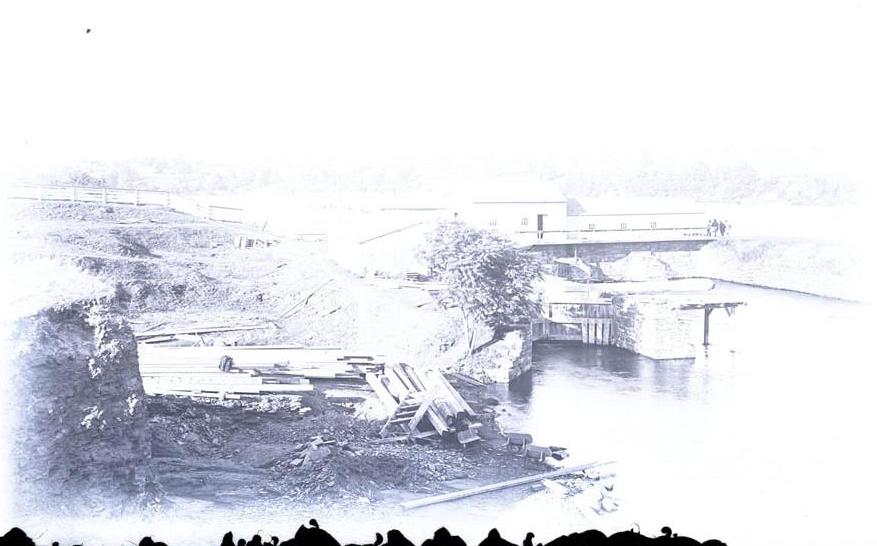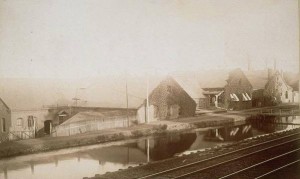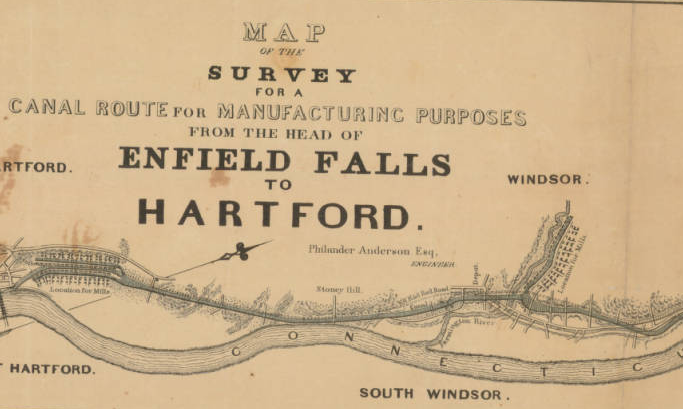In the early 19th century the Connecticut River was an important commercial transportation corridor and brought prosperity to the towns all along its banks. By 1824, however, the construction of the state-chartered Farmington Canal threatened to divert commercial traffic away from the Connecticut River. In response, local entrepreneurs formed the Hartford-based Connecticut River Company. The company’s mission was to build a canal around river rapids in Enfield to improve the navigability of the Connecticut River.
Construction on the canal began in June of 1827, and by October of that year, 400 men labored under the direction of Canvass White—the engineer who oversaw the building of the Erie Canal. Builders and engineers saw value not only in improving transportation on the river but also in outfitting the canal to harness the river’s power to produce energy. This secondary function proved immensely important less than 20 years later.

Lock at entrance to Enfield Canal, Windsor Locks, ca. late 19th-early 20th century – Connecticut Historical Society
The construction of the canal around Enfield Falls impacted local demographics. A significant portion of the labor for the canal came from Ireland. Consequently, an Irish population that made up approximately 1% of Windsor‘s residents prior to the canal’s completion made up almost 20% just 30 years later.
The canal opened in November of 1829 to great fanfare. The opening ceremonies included a demonstration of the first steamboats built for service on the river north of Hartford. For the next 15 years, scows carried goods around the rapids, while paddle steamers like the Agawam and the Phoenix provided daily passenger service between Hartford and Springfield, Massachusetts. One of these passengers was legendary author Charles Dickens, who traveled from Springfield to Hartford on February 7, 1842.
Dickens’s trip, however, came at a time when passenger travel on the Connecticut River had begun to decline. By the end of 1844, the Harford and Springfield Railroad had become the most effective way to move passengers and cargo through the area. It was then that the foresight of the canal’s builders became clear: as its utility for transportation faded, the canal became an important power source for a number of industries that emerged along its banks. The canal facilitated the construction of textile mills, paper mills, and foundries that prospered for another 100 years.

Factory beside canal, Windsor Locks, ca. 1900s – Connecticut Historical Society and Connecticut History Online
By the mid-19th century, the village that had grown up alongside the canal had earned the name “the Locks.” In recognition of the importance of the canal and the village in fostering local economic development, the area was given the name Windsor Locks in 1854. Today, as industry has moved out of the area, nature has returned, and the acres surrounding the canal have become a favorite place for residents to hike, fish, bicycle, and watch birds and other populations of burgeoning wildlife.









